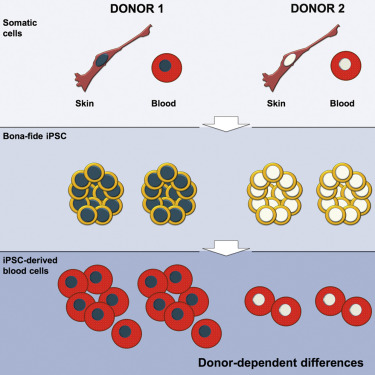|
|||||||||||||||
|

CLICK ON weeks 0 - 40 and follow along every 2 weeks of fetal development
|
|||||||||||||||||||||||||||
| Donor's genome impacts iPS cell outcomes Induced pluripotent stem cells [iPS cells] made from different body cells are equally capable of being reprogrammed — no matter what organ cells they originated from. But, the genotype of a donor does affect their differentiation behavior, according to a recent study from Finland. Under laboratory conditions, iPS cells can be made from human cells from varying organ systems. They can be cultivated in unlimited amounts and when needed, be made into cell types such as heart, liver or nerve cells. Medical research uses induced pluripotent cells in many different ways — such as in the study of disease mechanisms and in drug screenings. They are perfect for biobanking as they can easily be derived from fibroblast cells cultivated from a piece of skin, or grown directly from blood cells. Blood cells are the most useful biobank material as taking a blood sample is simple and done frequently. However, there were some who questioned whether iPS cells derived from different cell types are fully equal, or whether their differentiation could be influenced by the variety of tissue types the cells were derived from. To settle the matter, researchers from the University of Helsinki compared characteristics of iPS cells made from skin to those made from blood. Using a comprehensive range of analytic methods, researchers examined DNA methylation in stem cells. Their focus being whether human iPS cells had an "epigenetic memory."
According to Professor Timo Otonkoski from the University of Helsinki: "It is obvious that pluripotent stem cells derived from different cell types are fully equal. These results are highly significant to biobanks ... and previously stored living cell samples remain useful for iPS cell production."
"Genetically determined individual differences in stem cell populations were surprisingly extensive. Functional genotypes related to an illness will require that bio-banks select a large variety of samples from several donors," said Timo Otonkoski PhD, Professor of Molecular Neurology at the Biomedicum Stem Cell Centre in the University of Helsinki in Finland Abstract Highlights http://www.eurekalert.org/pub_releases/2016-01/uoh-dgc011316.php#.VpsAXhmDLng.mailto
|
Jan 27, 2016 Fetal Timeline Maternal Timeline News News Archive
|
|||||||||||||||||||||||||||


